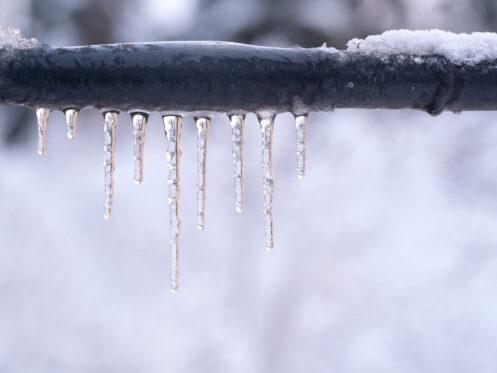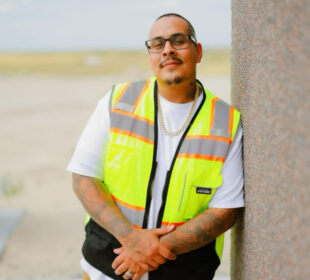Winters in Colorado can be bitterly cold, and one thing you have to be worried about is your plumbing freezing. The concern is less if you have a newer plumbing system and all of your water lines are PEX piping. That’s because PEX is flexible enough that it shouldn’t ever break if the water inside it freezes. However, copper piping is a different story and can easily break if the water inside it freezes and expands. The good news is that there are some fairly simple precautions you can take that should ensure frozen pipes aren’t an issue you really ever need to worry about.
Drain All of Your Outdoor Plumbing
One step you always need to take before the first freeze of the winter arrives is to fully drain all of your outdoor plumbing. This includes outdoor faucets, hose connections, and sprinkler systems. If you know where the shut-off valves for all of these fixtures are and can easily access them, this entire process shouldn’t take more than a few minutes. All it takes is closing each valve inside the house, going outside to turn each fixture on until no more water drains out and then again shutting each fixture off. However, you first need to unhook any hoses that are still connected so you can be certain the hose bib fully drains.
Upgrade to Frostproof Outdoor Faucets
This step is generally not something you need to worry about in Colorado, since non-frost-proof outdoor faucets or hose connections are extremely rare. Nonetheless, some older homes do have them, in which case you definitely want to upgrade them to the frost-proof kind before winter. The difference between the two is how far the stem extends into the house before connecting to the water line where the shut-off valve is located. With the frost-proof variety, you can drain water further away from the edge of the foundation so there’s less chance of the pipe freezing.
Have a Professional Inspect and Insulate Your Plumbing
An important step to take is to have a plumber inspect your pipes and determine which ones have the highest chance of freezing. This mainly means pipes in a crawlspace and those located directly along a bare concrete foundation wall in the basement. The plumber can then fully insulate all of those pipes so that there’s almost no chance they’ll freeze unless your heating is out for a longer time and your home gets extremely cold.
Turn the Water On
Once the temperature drops below zero, as it often does here, there’s a far higher risk of your plumbing freezing if you don’t leave water running from your faucets and showers. All it takes is having a trickle of water running to almost guarantee your plumbing doesn’t freeze. That’s because it keeps water continuously moving through your plumbing system instead of the water just standing still within your pipes and potentially cooling down to the point it can freeze.
Take Additional Precautions Before Leaving for a Winter Vacation
If you plan on being gone during part of the winter and don’t have anyone checking on your home while you are away, you should take some additional precautions. Before leaving, it’s generally recommended to turn your heating down to 50 degrees. That way your house should stay sufficiently warm to prevent your plumbing from freezing while at the same time ensuring your heating doesn’t run needlessly and waste lots of energy. If your tank water heater has a “vacation” setting, it’s also a good idea to switch to it so you can save energy. When on this setting, the water inside the tank will only get heated to around 50 degrees to prevent it from freezing.
Before leaving, you should also turn off the water to your house. That way major flooding won’t occur in the event that your heating stops working and any pipes freeze and burst. If you’ll only be gone for a couple of days, just shutting your water off is usually sufficient. If you spend the winter elsewhere or will be gone for any extended period of time, you should take the following extra steps to fully winterize your house.
Drain Your Entire Plumbing System
After shutting your water off, you’ll then want to fully drain your entire plumbing system including your water heater. The first step is to turn your water heater off and wait at least a few hours so the water inside the tank cools enough that you don’t risk getting scalded when draining it. Once the water is sufficiently cool, you need to attach a hose to the water heater, close the valve on the cold water intake pipe and open the drain valve. However, you also need to turn a faucet on to hot or else the tank won’t drain.
You can then start draining all of the water out of both your cold and hot water pipes. The first step is to open all faucets and showers on the top floor. This allows air to get inside the pipes. If you don’t take this step, a vacuum can form inside some pipes that prevents the water from draining. You can then go floor by floor and open all fixtures until no more water comes out.
It is advisable to hire a plumber if you don’t know exactly what to do. In fact, doing so is generally always the best way to go so you can make sure the process is done correctly and no water remains in any of your pipes. That’s because a plumber can hook an air compressor to part of the plumbing system and blow the pipes out, which is often the only way to make sure everything fully drains.
Pour Antifreeze into Your Toilets and Drains
The other thing you need to do is make sure to shut the water off to each toilet and then flush as much of the water out of the tank and bowl as possible. You usually won’t be able to get all of the water out unless you either sop it up with a towel or suck it out with a wet/dry vacuum. As such, it’s a good idea to also pour antifreeze into both the bowl and tank. However, you want to make sure you use non-toxic antifreeze that’s specifically designed for winterizing plumbing.
You should also make sure to pour some antifreeze down every drain in your house. That’s because even after you fully drain your entire plumbing system, some water will remain within the P-trap underneath all of your drains. If the water in the trap freezes, the pipe will likely crack and immediately start leaking as soon as you come home and start using your plumbing again.
Whether you’re concerned about your pipes freezing or need any other plumbing, HVAC or excavation service in Colorado Springs, you can rely on the expert team at Alphalete Plumbing Drain Heating & Air. We’ve been serving the area for the past decade and are dedicated to performing top-tier work and providing first-rate customer service, including cooling and heating repair. To schedule an appointment or get honest answers and advice, contact us today.


